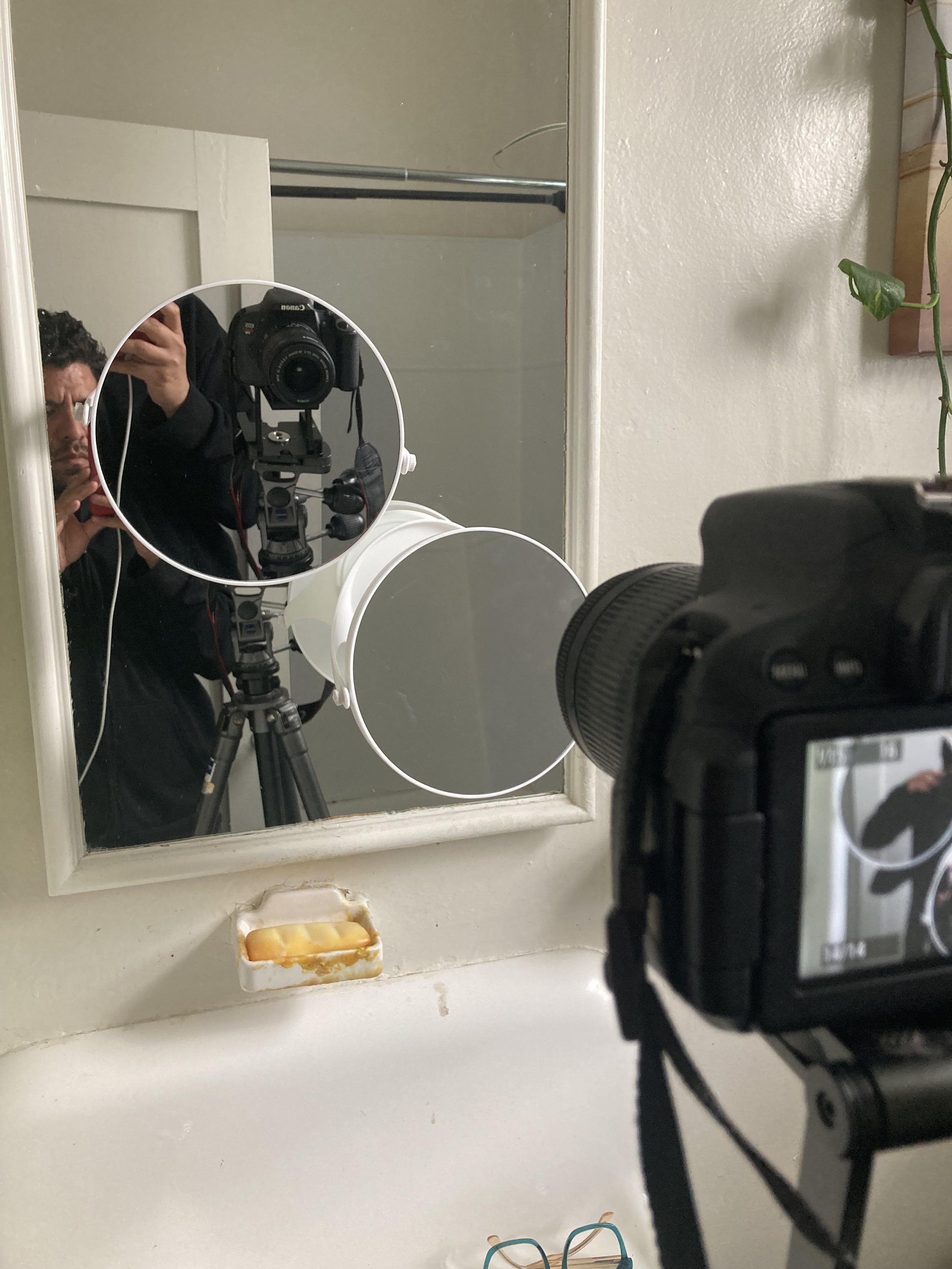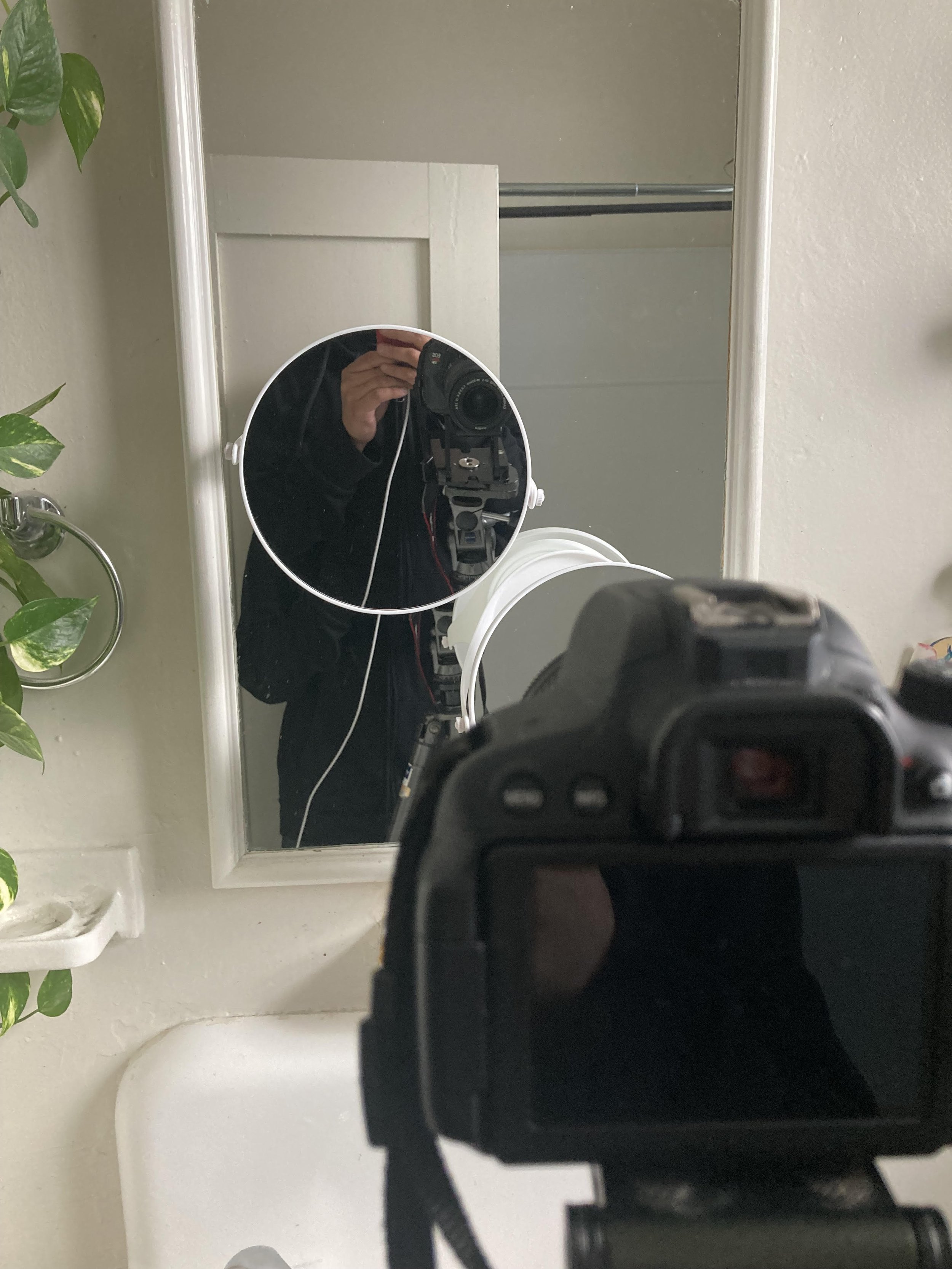Meshes On An Afternoon
Christopher Velasco
Meshes On An Afternoon, Inkjet print, 8.5 x 11 inches
“If you can sell bullshit, then you did it. You’re an artist.”
Interview by C. VanWinkle
February 13, 2023
I suppose we should start at the beginning. Can you tell me about the prompt that you responded to?
The image that was sent to me was a painting. I think it was acrylic. It was of a person holding their phone and taking a self-portrait with the mirror, so it was a dual kind of image. The colors were dark greens, magentas, in that range. If you were to look at it photographically, I think it's late afternoon, almost early dusk. That’s the best way to describe it. When I saw that image, I immediately thought of what I was going to do with mine.
What was your plan?
I was gonna do a mirror selfie, but understanding how photography plays with perception, thinking about mirrors and whatnot. I wasn't trying to do a literal translation of the prompt. It was about what I could do with what I was given and play with it. Also, in Bait/Switch I see a lot of drawing and painting, but not a lot of photography, so this was my opportunity to stand out. That’s why I went that route.
You were working in wheelhouse that you're already really comfortable with. Some people come to this project and do something akin to what they’re already working on, and some people use this as an opportunity to do something they’ve never done before. There’s really no wrong approach there.
Yeah, it’s great to experiment. Speaking for myself, I knew what I was going to do immediately, what I needed and how long I needed to do it. I thought, “I don’t know exactly how it’s going to come out, but it’s going to come out.” It was that pre-visualization that Ansel Adams talked about in photography. That's something I always think about. When I see an image, I might think, “I see how it's going to look. I don't know how it's going to get there yet, but I'm going to pre-plan it.” I knew it was going to be a black-and-white because that would stand out against all the color.
That's true!
My mentality is always thinking about the big picture. If I know it’s going to go into the magazine, I'll probably stand out because most everybody is going to think color. I decided to make it very filmic, too. I was inspired by the director Maya Deren. I watched “Meshes of the Afternoon” and wondered what I would do in my own version of that.
Wow, you’re quite the pre-visualizer!
Like you said earlier, I stuck to my wheelhouse. I knew what I wanted and how I was going to set it up, so I went to Target, got some supplies, came home, and did it before I had to go teach. I got the image in Photoshop and it was ready to go.
It was about angles. I was focused on trying to get the right angle for what I was going for, so of course I took a bunch of pictures. In other instances, it would take more than a certain number of images to get what I was looking for, but when I took this shot, I just knew it. I saw it on my camera and thought, “This is the one.” I think it's the last shot I took, to be honest. I took about ten images and that was the last shot. I knew when to stop. Otherwise, I would end up going too far, and I’d realize I should have just stopped.
I think that can be a challenge in any creative discipline, to know when to stop. I thought it was really interesting that you looked at this painting photographically, determining the time of day, even though that may or may not have even crossed the mind of the painter.
Oh I know, because they were just painting, thinking about the color. Like painting, I think color and tone. Contrast and value. I think about it all the time: color temperature, time of day. Most importantly, light. Photographers, like painters, use light to create value – the adding of white and black pigment into their color to produce contrast – whereas photographers capture light to paint an overall image with all the values of white, gray, and black. I might think, “I don’t know if I like that hue of yellow because of the light.” When I saw the painting, I saw what they were doing, the pose and everything, and I wanted to see how much I could take it further for myself, just using black and white values.
How does this piece relate to the rest of your work?
That's a good question. I think the black-and-white aesthetic is close to what I to do in my own photography. And it’s very cinematic, very inspired by cinema. I tried to make this image look like it was film, so I did a lot of technical stuff to get that look. I think that's something that is missing a lot now with digital because everybody wants to make it so smooth. The pixels make the image more interesting. I've seen images that are sharp and look great and they spark something in me. Other times, they don’t. It’s just my taste.
As a teacher, if the student made something that wasn’t very good and then they did something else and improved, I'm very happy that they went sharp. But for myself as a photographer, I'm very nitpicky about what I like and don't like, and how the image is supposed to look.
How has teaching affected your own practice?
Working with photography students, you're relearning your skills. It helps you sharpen your own skills by helping them sharpen theirs. I think of teaching as very collaborative. High school is a whole other demon in itself. You’re teaching more behavioral things rather than just art because they’re so young. You’re teaching the basics and saying, “Hey, you’re doing great, don’t give up.” At a community college or university level, it’s getting them to sharpen their skills and get better and feel confident. Overall, I would say confidence is the most important thing to teach because if they have confidence then they can do anything. And that's something I believe in. I'm always trying to push them, especially the queer kids in my classes. And I tell them, “It's not arrogance, it’s confidence.” If you believe in yourself and you are humble about it, you'll be fine.
Also, if you can sell bullshit, then you did it. You're an artist. I even tell that to my community college students. If something isn’t color-corrected and you wanted it blue, if you can sell me on why that that’s blue, then you get your grade. But if you can't, you need to go back and fix it. Anyway, that’s what teaching is about for me right now. It may change in like 10 years, but right now, I just started, so I’m more excited.
How did you like working from a prompt?
It was kind of fun. There were no limitations, which was great. It just gave me this fun, artistic thing to do. “Oh, I gotta do this!” And I don’t know, maybe I might do a series of it, do a couple variations, try different poses, different locations. I don't know yet.
If you take this idea anywhere else, we would love to see it! That sounds awesome. Not knowing your work super well, I assumed whatever you would create for this would be some form of photography or a video/performance type of thing.
I could have done performance, but then sometimes self-portrait photography is performance if you think about it. Originally, I was trying to hide my face to be different from the selfie. I was trying to look like the creature in the movie “Meshes of the Afternoon.” There's this creature wearing a black robe and their face is a mirror. I was trying to emulate that, but it just wasn't working in some of the shots, so I thought, “Okay, fine, let's just show my face.” That's why I appreciate the distortion of my face going in different directions.
Yeah, your face is split into five different pieces and they're not all from the same angle. That's really cool. Did you find working from a prompt to be more freeing or more limiting?
I thought I was a little freer. I think for some people it probably depends. They might want more freedom or more structure. It depends on the person. I thought it was fine, I liked it.
Also, the interpretation of what is expected depends on the person. Some people will make a thing that looks more like the prompt or is some sort of clear, semi-faithful interpretation or something. Others will just use that as a jumping-off point and go into outer space and do something completely different. What's your advice to another newbie approaching this project for the first time?
Let's see. Don't take the prompt too seriously. Have fun with it and see where your energy goes with it. Trust your gut to see which way you want to go. Explore and experiment. I don't think that people should try to do a literal translation of the prompt, speaking for myself. I just saw something and thought, “I want to do this because I think it would look cool.” I wanted to do something actually new for this.
Call Number: C91VA | C93VA.veMe
Christopher Anthony Velasco is a photographer and performance artist who lives and works in Los Angeles. He received his Master of Fine Arts from UC Santa Barbara in 2019 and his BFA from California Institute of the Arts. Velasco is an instructor at Ventura College and Los Angeles Valley college, along with CSSSA (California State Summer School of the Arts). Image credit: Juan Silverio





